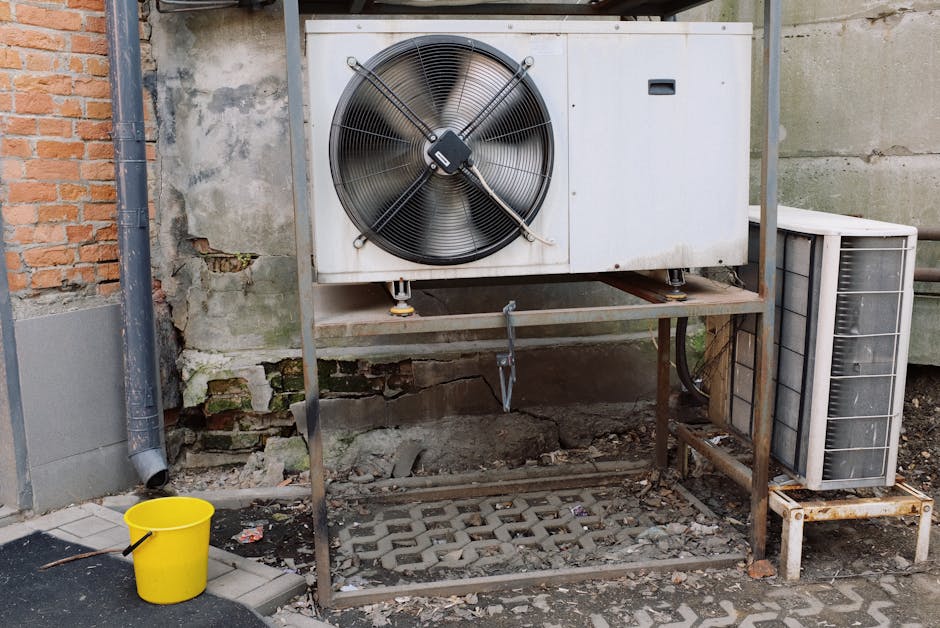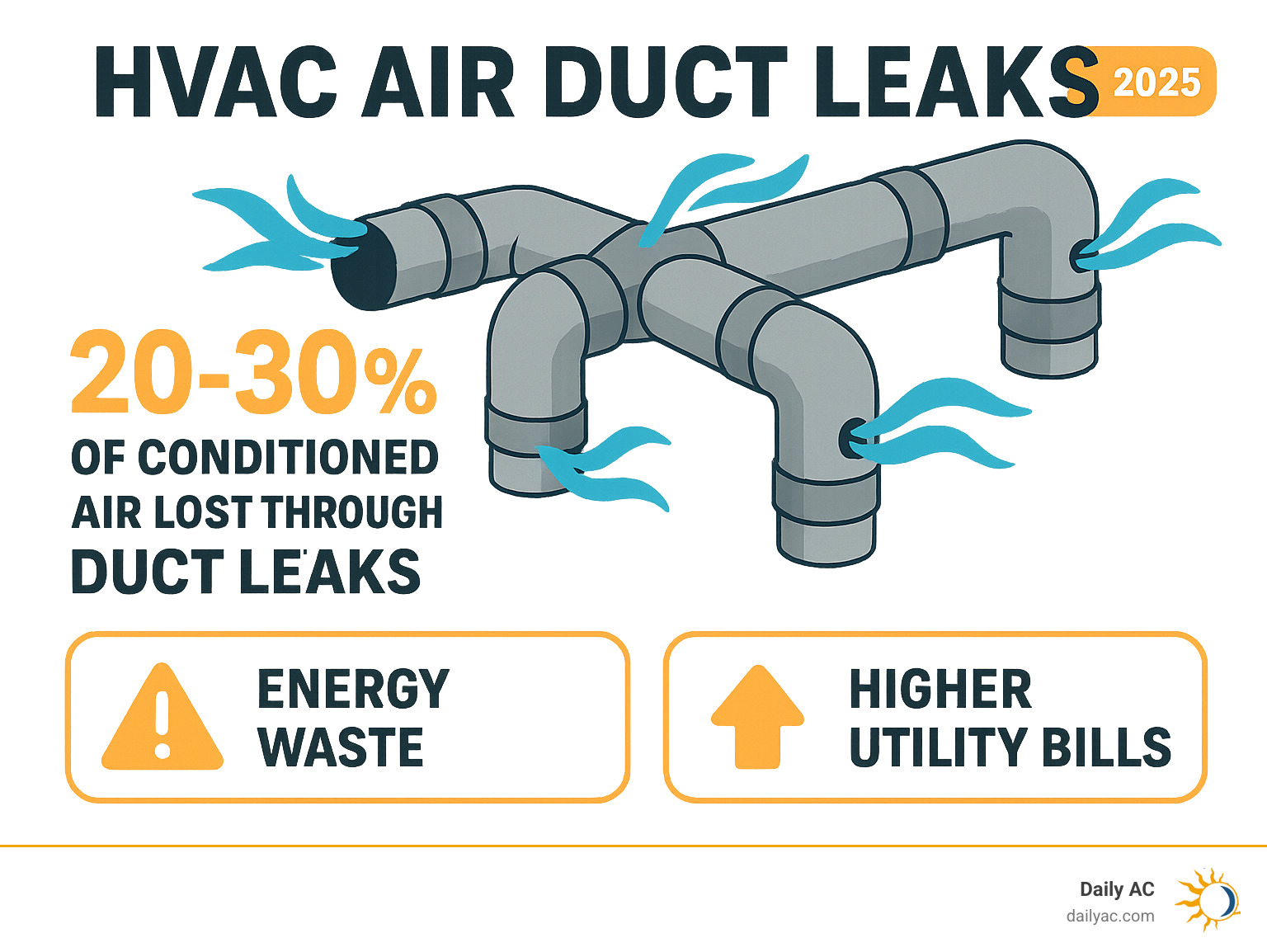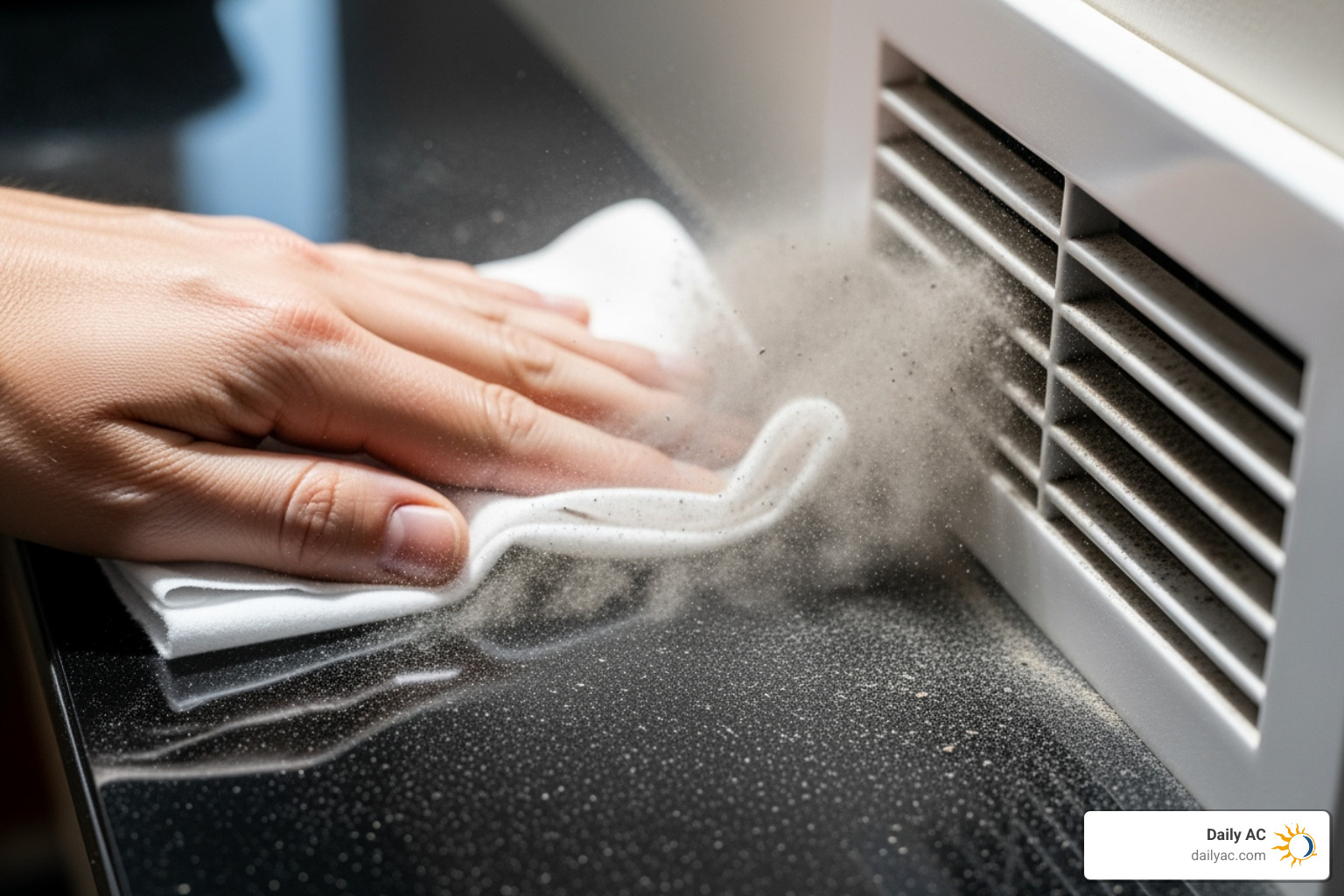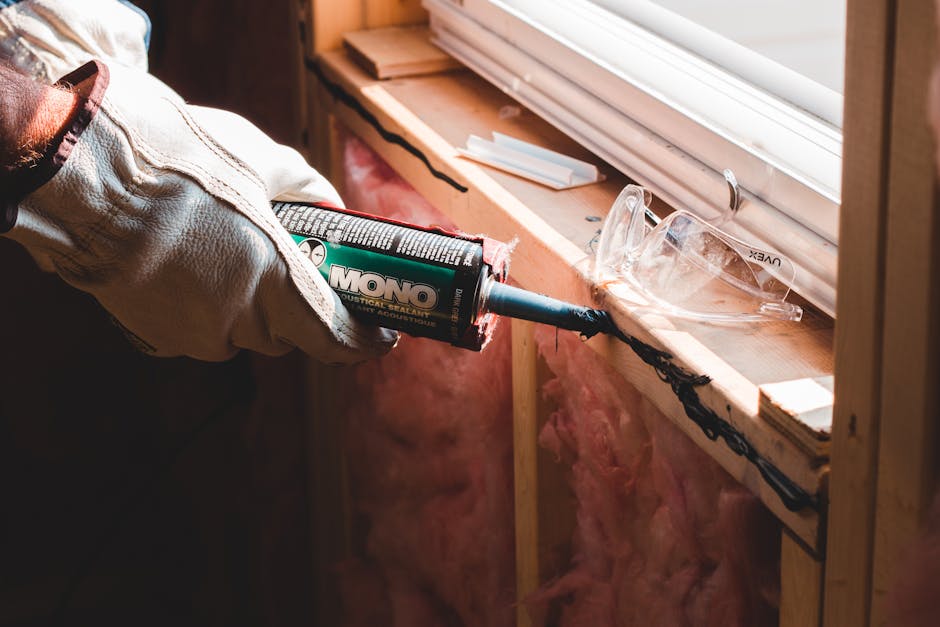Why HVAC Air Duct Leaks Are Stealing Your Comfort and Cash
HVAC air duct leaks occur when conditioned air escapes through holes, cracks, or poor connections in your ductwork before reaching your living spaces. These invisible energy thieves are far more common than most homeowners realize.
Quick Answer: What You Need to Know About HVAC Air Duct Leaks
- Energy Loss: 20-30% of conditioned air typically escapes through duct leaks
- Common Signs: High energy bills, uneven temperatures, excessive dust, weak airflow
- Main Causes: Poor installation, aging materials, pests, home renovations
- Detection Methods: Visual inspection, smoke tests, feeling for drafts
- DIY Solutions: Mastic sealant and foil tape for accessible minor leaks
- Professional Help: Required for extensive damage or hard-to-reach areas
Your home’s ductwork is like the circulatory system of your HVAC unit. When it’s working properly, cool air flows efficiently to every room. But when leaks develop, it’s like having cuts in your arteries – your system works harder while delivering less comfort.
According to ENERGY STAR®, 75% of buildings have duct leakage. In a typical home, about 20 to 30 percent of the air that moves through the duct system is lost due to leaks, holes, and poorly connected ducts. That’s like throwing money out the window every time your AC or heater runs.
The good news? Many duct leaks are detectable and fixable. Some you can handle yourself, while others need professional attention. Understanding what to look for and when to take action can save you hundreds of dollars on energy bills while keeping your family more comfortable year-round.
The Hidden Costs of Leaky Ducts: More Than Just Wasted Air
Leaky air ducts are like a hole in your gas tank; you’re paying for conditioned air that never reaches its intended destination. This isn’t just a minor inconvenience—it’s a major problem with consequences for your wallet, comfort, and health.
Why Leaky Ducts Hurt Your Wallet and Comfort
First, HVAC air duct leaks drain your finances. The U.S. Department of Energy estimates that the average home loses 20–30% of its conditioned air through duct leaks. This forces your HVAC system to work harder and run longer to compensate, consuming more energy and driving up your monthly utility bills.
Beyond the financial impact, leaky ducts harm your home’s comfort. Are some rooms always too hot or too cold? These “hot and cold spots” are a classic sign of duct leakage. Conditioned air escapes into attics, crawlspaces, or walls instead of reaching your living spaces, leading to inconsistent temperatures and poor airflow. If you’re struggling with uneven temperatures, our guide on Solutions for Poor Airflow from Ductwork might offer some additional insights.
This increased strain also shortens your HVAC system’s lifespan. More wear and tear leads to more frequent repairs and potentially an earlier replacement. Fixing duct leaks can improve your system’s efficiency by as much as 20%, saving you money and extending the life of your equipment.
How Duct Leaks Impact Your Home’s Health
Leaky ducts also significantly affect your indoor air quality (IAQ). While your ductwork should deliver clean, filtered air, leaks in return ducts can pull unfiltered air from unconditioned spaces.
Ducts in attics or crawlspaces are surrounded by dust, insulation particles, mold spores, pest droppings, and other contaminants. Leaky return ducts allow your HVAC system to suck in these pollutants and distribute them throughout your home, leading to:
- Excessive dust and allergens: You might notice a constant battle with dust or increased allergy symptoms.
- Mold and mildew: Leaks can introduce moisture, creating ideal conditions for mold and mildew growth within the ductwork, which then releases spores and musty odors into your home.
- Contaminants from attics and crawlspaces: Dangerous substances like carbon monoxide or insulation fibers can be pulled into your air supply.
Leaky ducts can turn your HVAC system from an air-conditioning unit into an air-contaminating one. For more information on how your ducts might be affecting your well-being, read our article: Are Your Air Ducts Making You Sick?.
Telltale Signs: Is Your Home Losing Conditioned Air?
When it comes to HVAC air duct leaks, the signs are usually there if you know what to look for. These clues can seem like everyday annoyances, but recognizing them reveals what your home is trying to tell you about its duct problems.
The most telling sign is skyrocketing energy bills. If your costs jump without an obvious reason, leaky ducts are a likely culprit. You’re paying to condition air that escapes before it reaches you.
Inconsistent room temperatures are another dead giveaway. If some rooms are uncomfortable no matter the thermostat setting, you’re likely dealing with duct leaks because conditioned air isn’t making it where it needs to go.
Also, pay attention to weak airflow from your vents. If some rooms have strong airflow while others have almost none, that’s a red flag.
Excessive dust that appears no matter how much you clean is another sign. Leaky return ducts can pull in dust and debris from attics or crawlspaces and spread it throughout your home.
Finally, listen for strange noises like hissing or whistling when your HVAC runs. These sounds often indicate air escaping through cracks or loose connections.
Common Causes of Air Duct Leaks
Understanding what causes these leaks can help you prevent them. Poor installation is unfortunately common. When ductwork isn’t properly sealed from the start, you’re dealing with problems that only get worse.
Aging ductwork is a common culprit. Over the years, seals dry out, tape fails, and connections loosen. Constant temperature changes stress every joint. If your system is older, our guide on Warning Signs of Aging Ductwork can help you spot potential issues.
Wear and tear from daily use, physical impacts, or even settling foundations can create or worsen leaks. Sometimes it’s as simple as someone stepping on ductwork in an attic.
Don’t underestimate pests. Rodents love to chew through duct materials, and insects can find their way into the smallest openings.
Home renovations can also accidentally damage ductwork, especially when contractors are working in attics, basements, or walls where ducts run.
For homes in our South Florida service area, humidity and temperature fluctuations are particularly hard on ductwork, accelerating the breakdown of sealants and making regular inspections even more important.
Understanding Different Types of Duct Leakage
Not all leaks affect your home the same way. Supply leaks happen in the ducts carrying conditioned air to your rooms. When these leak, you lose expensive heated or cooled air, creating hot and cold spots while wasting energy.
Return leaks occur in ducts bringing air back to your system. These are problematic because they can pull in unfiltered air from attics, crawlspaces, or wall cavities, reducing efficiency and introducing contaminants into your indoor air.
Equipment leaks happen at the air handler cabinet, furnace connections, or plenum connections where air pressure is highest. A leak here can significantly impact your entire system’s performance.
Playing Detective: How to Find Hvac air duct leaks
Many HVAC air duct leaks are hiding in plain sight. While some leaks require professional help, many are accessible in your attic, crawlspace, or basement. With a little detective work, you can identify these energy thieves and decide on the next steps.
You don’t need fancy equipment for this inspection—just your eyes, hands, and maybe an incense stick to find where your conditioned air is escaping.
A Step-by-Step Visual Inspection Guide
Start with a visual inspection of all accessible ductwork. With a flashlight, head to the unconditioned spaces where your ducts are located, like the attic, crawlspace, basement, or utility closets.
Start by checking connections where duct sections meet. These joints are where most failures happen. Look closely at where ducts connect to each other, to your furnace or air handler, and to registers and grilles.
Next, examine the duct material itself for tears, holes, or punctures. Flexible ducts are especially vulnerable. You might even find entire sections that have become disconnected, dumping all your conditioned air into the attic or crawlspace.
Pay special attention to dirty spots or discoloration around seams and joints. This “ghosting” effect happens when air carrying dust escapes through small openings. If you see grimy or darkened insulation around duct connections, you’ve likely found a leak.
Important safety tip: Turn off your HVAC system before you start inspecting ductwork.
Simple Tests to Pinpoint Your Hvac air duct leaks
Once you’ve completed your visual survey, it’s time for some hands-on testing to confirm suspected leaks.
The smoke test is a surprisingly effective tool. Turn your HVAC system to “fan only” to get air flowing. Light an incense stick or smoke pencil and move it slowly near all seams, joints, and connections.
Watch the smoke. If it gets sucked into a crack or blown away from a joint, you’ve found a leak. The air pressure reveals exactly where air is escaping. This method also works around registers and grilles.
For a more tactile approach, try the “ghost” test by carefully running your hand around duct seams and connections while the system runs. Even a faint draft can reveal a leak. This works well around the larger connections near your air handler where pressure is highest.
Don’t forget to check for dirty insulation if your ducts are wrapped. Soiled or discolored insulation indicates that air has been moving through it.
The ENERGY STAR® program offers additional guidance in their comprehensive Do-It-Yourself Guide to Seal and Insulate with ENERGY STAR, which can help you take your investigation to the next level.
Your goal is to identify the major culprits stealing your comfort and cash. Once you know where the problems are, you can decide whether to fix them yourself or call a professional.
Sealing the Deal: DIY Fixes vs. Professional Repair
You’ve found the HVAC air duct leaks; now it’s time to seal them. The approach is similar to patching a garden hose: small punctures are often a DIY job, while bigger tears may need professional help.
Duct sealing is your go-to solution for most leaks, using specialized materials to patch gaps. When damage is more severe, duct repair is needed to patch or replace damaged sections. For systems beyond help, duct replacement becomes necessary.
Recommended DIY Methods for Sealing Minor Hvac air duct leaks
A quick word on gray “duct tape”: despite its name, it’s the worst thing to use on actual ducts. The adhesive breaks down with temperature changes, and the seal will fail within months.
Mastic sealant is ideal for sealing seams, joints, and holes up to a quarter-inch. This paint-like substance creates a durable, airtight seal that handles temperature swings. Apply a layer as thick as a nickel with a paintbrush. For gaps over 3/8 inch, reinforce the mastic with fiberglass mesh tape.
UL 181-rated foil tape is another excellent choice for metal ducts. It’s a heavy-duty, adhesive-backed aluminum tape that forms a strong bond and withstands temperature changes. The UL 181 rating is crucial, as it signifies the tape meets safety and performance standards for ductwork.
| Material Type | Recommended Use | What to Avoid |
|---|---|---|
| Mastic Sealant | Ideal for seams, joints, and small holes (up to 1/4 inch). Creates a durable, airtight seal. For larger gaps (over 3/8 inch), use with fiberglass mesh tape. Apply minimum thickness of a nickel. | Standard caulk or silicone (not designed for ducts) |
| UL 181-Rated Foil Tape | Excellent for sealing seams and small holes on metal ducts. Heavy-duty, adhesive-backed aluminum tape that withstands temperature changes. Must be UL 181-rated for safety standards. | Standard cloth-backed “duct tape” (adhesive fails quickly) |
Before you start, clean the surface thoroughly. Dust and grease are the enemies of a good seal. Once clean and dry, apply your chosen material generously, overlapping the leak area by at least an inch on all sides.
When to Call a Professional for Ductwork
While DIY fixes for accessible leaks can be satisfying, some situations require professional expertise.
Hard-to-reach leaks are the most obvious reason to call the pros. If leaks are behind walls, in cramped crawlspaces, or high in an attic, leave it to the experts who have the right tools and experience.
Extensive damage goes beyond a simple patch. Large holes, disconnected sections, or deteriorated ductwork require proper repair or replacement. Our guide on the Importance of Professional Duct Work Repair explains why expertise matters for these issues.
If you’ve sealed visible leaks but problems persist, you likely have hidden leaks. Professionals use professional pressure testing (a duct blaster test) to measure total air loss and pinpoint every hidden leak.
An advanced solution is Aeroseal technology. This process injects a polymer sealant into your pressurized duct system. The sealant particles automatically find and seal leaks from the inside without tearing open walls or ceilings.
For homeowners in South Florida, our team provides comprehensive Duct Work Repair Residential Properties services, ensuring your home stays comfortable and energy-efficient.
Frequently Asked Questions about Duct Leaks
Homeowners often have questions about HVAC air duct leaks. Here are answers to the most common ones.
How much energy is actually lost through leaky ducts?
The U.S. Department of Energy and ENERGY STAR® estimate that the average home loses 20-30% of the air that moves through the duct system due to leaks, holes, and poor connections. This means if you spend $200 a month on heating and cooling, $40 to $60 could be disappearing into your attic or crawlspace. Fixing these leaks can lead to noticeable savings, with many homeowners seeing a 15-20% reduction in energy costs after professional duct sealing.
Can I use regular gray duct tape to seal my air ducts?
This is a common question, and the answer is a firm no. Despite its name, standard cloth-backed duct tape is terrible for sealing ducts. Its adhesive isn’t designed for the temperature swings in ductwork, especially in Florida’s climate. The adhesive dries out, cracks, and peels off, often within a year, rendering the repair useless. Always use mastic sealant or UL 181-rated metal foil tape, which are engineered for HVAC systems and create a durable, long-lasting seal.
How often should I have my ductwork inspected?
We recommend a visual ductwork inspection during your bi-annual HVAC maintenance tune-ups, especially for systems over 10 years old. A basic check for obvious issues is typically included. However, if you have persistent comfort problems or climbing energy bills despite regular maintenance, a more comprehensive duct inspection is needed. This may include pressure testing to find hidden leaks. In South Florida, more frequent inspections are wise due to our humidity and temperature fluctuations, which accelerate duct deterioration.
Take Control of Your Comfort and Efficiency
You now have the knowledge to fight back against the sneaky HVAC air duct leaks sabotaging your home’s comfort and wallet. Every day you wait, more money is lost. When you seal those leaks, you’re not just plugging holes—you’re improving your entire home experience.
Improved comfort becomes immediately noticeable. No more moving from a freezing room to a sweltering one. Your home will finally feel consistently comfortable in every corner.
Lower energy bills follow close behind. An efficient HVAC system uses less energy, which means more money stays in your pocket each month.
Healthier indoor air is another wonderful benefit. By sealing return duct leaks, you’ll stop pulling in dust, allergens, and other contaminants from your attic or crawlspace, allowing your family to breathe easier.
Your HVAC system will thank you too. Less strain means less wear and tear, leading to fewer breakdowns and a longer lifespan for your equipment.
Addressing duct leaks is a home improvement with immediate benefits. Unlike some upgrades that take years to pay off, sealed ducts start saving you money from day one.
Whether you tackle accessible leaks yourself or call in professionals, you’re making a smart investment. Proactive maintenance like this prevents small problems from becoming expensive headaches.
If you’re in Davie, FL, or the surrounding areas like Plantation, Miramar, Fort Lauderdale, North Miami Beach, or West Palm Beach, our team at Daily AC understands the unique challenges of Florida’s climate. We’re committed to providing high-quality service with our capable, friendly team.
Ready to stop those energy thieves in their tracks? Schedule Your Professional Duct Work Service in Davie, FL with Daily AC today. Your comfort – and your wallet – will thank you.









